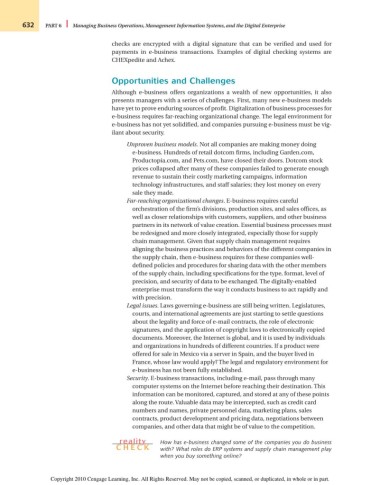Page 658 - Introduction to Business
P. 658
632 PART 6 Managing Business Operations, Management Information Systems, and the Digital Enterprise
checks are encrypted with a digital signature that can be verified and used for
payments in e-business transactions. Examples of digital checking systems are
CHEXpedite and Achex.
Opportunities and Challenges
Although e-business offers organizations a wealth of new opportunities, it also
presents managers with a series of challenges. First, many new e-business models
have yet to prove enduring sources of profit. Digitalization of business processes for
e-business requires far-reaching organizational change. The legal environment for
e-business has not yet solidified, and companies pursuing e-business must be vig-
ilant about security.
Unproven business models. Not all companies are making money doing
e-business. Hundreds of retail dotcom firms, including Garden.com,
Productopia.com, and Pets.com, have closed their doors. Dotcom stock
prices collapsed after many of these companies failed to generate enough
revenue to sustain their costly marketing campaigns, information
technology infrastructures, and staff salaries; they lost money on every
sale they made.
Far-reaching organizational changes. E-business requires careful
orchestration of the firm’s divisions, production sites, and sales offices, as
well as closer relationships with customers, suppliers, and other business
partners in its network of value creation. Essential business processes must
be redesigned and more closely integrated, especially those for supply
chain management. Given that supply chain management requires
aligning the business practices and behaviors of the different companies in
the supply chain, then e-business requires for these companies well-
defined policies and procedures for sharing data with the other members
of the supply chain, including specifications for the type, format, level of
precision, and security of data to be exchanged. The digitally-enabled
enterprise must transform the way it conducts business to act rapidly and
with precision.
Legal issues. Laws governing e-business are still being written. Legislatures,
courts, and international agreements are just starting to settle questions
about the legality and force of e-mail contracts, the role of electronic
signatures, and the application of copyright laws to electronically copied
documents. Moreover, the Internet is global, and it is used by individuals
and organizations in hundreds of different countries. If a product were
offered for sale in Mexico via a server in Spain, and the buyer lived in
France, whose law would apply? The legal and regulatory environment for
e-business has not been fully established.
Security. E-business transactions, including e-mail, pass through many
computer systems on the Internet before reaching their destination. This
information can be monitored, captured, and stored at any of these points
along the route. Valuable data may be intercepted, such as credit card
numbers and names, private personnel data, marketing plans, sales
contracts, product development and pricing data, negotiations between
companies, and other data that might be of value to the competition.
reality How has e-business changed some of the companies you do business
CH ECK with? What roles do ERP systems and supply chain management play
when you buy something online?
Copyright 2010 Cengage Learning, Inc. All Rights Reserved. May not be copied, scanned, or duplicated, in whole or in part.

